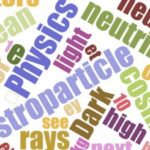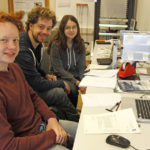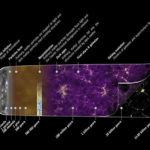
World Record for Compact Particle Accelerator
8 December 2014
LBNL News Release – World Record for Compact Particle Accelerator

8 December 2014
LBNL News Release – World Record for Compact Particle Accelerator

5 December 2014
The third International Cosmic Day took place on 8 October 2014 . On this day students worldwide learn about astroparticle physics with hands-on activities, sharing the experience of how researchers work and communicate with each other. Students get in contact with astroparticle physicists and have a first insight into their research and experimental methods, they even get the chance to collaborate with them.
The relatively young research field of astroparticle physics has been developing dynamically over the last few years. It is one of the most exciting areas of research, connecting particle physics (studying the microcosm of elementary particles) with astrophysics and cosmology (studying the biggest structures in the universe and their evolution over cosmic times). One of the very interesting challenges in astroparticle physics is to understand the acceleration mechanisms of cosmic ray particles to very high energies, much higher than accelerators on Earth can reach.
Cosmic ray particles travel over huge distances through the Milky Way. Those which arrive at earth interact with the air in the atmosphere and produce a shower of new particles. Some of these can be detected on the ground, and scientists can learn a lot about the universe from them. On the International Cosmic Day, students around the globe can learn about cosmic rays (What are cosmic particles? Where do they come from? How can they be measured?) and carry out experiments with secondary cosmic ray particles in universities, research institutions or even their classrooms. They are able to analyze cosmic ray data, discuss about and learn from their results.
The 3rd International Cosmic Day on October 8, started early in Japan and China, and continued over India, Georgia, Romania, Ukraine, Italy, Germany, Switzerland, and England, ending late that day in Mexico and the USA (see the map for details). The students started their day mostly with listening to introductory talks about the exciting field of astroparticle physics. This motivated them to start, immediately afterwards, planning and executing their own experiments in order to measure secondary cosmic ray particles.
Just like scientists, the students had to measure, analyze, interpret, and discuss their data. Next, they recorded their results and proceeded with the important step of discussing their experiments with student groups from all the participating countries, as it indeed happens within the international scientific community. This was facilitated by the organization of two Skype video conferences in different time slots to accommodate the time differences between participating countries.
At the end of the day, each student group had to write a one-page report about their experiment and results. These publications, together with a short introduction about the university, research institute or school where the event took place, will be combined to a booklet and will be sent out to all participants. Furthermore, every student will receive a certificate for her/his research participation in the International Cosmic Day 2014.
An organizer from Italy wrote about her impression of the day: “The students left so happy and excited for analyzing and publishing data and also because they were able to interact during data taking.”, while an organizer from Mexico summarized it with the words: “This day has been incredibly exciting.” Arne Schoenwald, who together with colleagues from DESY Zeuthen, organized the event this year said: “The ICD 2014 needed a lot of organization and coordination, but I enjoyed the opportunity to be in contact with so many very motivated colleagues, teachers, and organizers, without whom the ICD could not take place. So a big thanks to all the local organizers and the support of DESY Zeuthen, who made this day possible!”
The 3rd International Cosmic Day on October 8, 2014 was organized by DESY, Fermilab, QuarkNet, and Netzwerk Teilchenwelt. DESY in Zeuthen has the leadership for the astroparticle project in the Netzwerk Teilchenwelt, and this is where the idea of the International Cosmic Day was born a few years ago.
To learn more about the ICD and the supporting institutions:
International Particle Physics Outreach Group
Participation Map
DESY
Fermilab
Quarknet
Teilchenwelt

3 December 2014
TACC University of Texas News – Science powerhouses unite to help search for gravitational waves

3 December 2014
Wired News – You can help physicists make the next Higgs boson discovery

2 December 2014

1 December 2014
Scientific American – Neutrinos on Ice: How to Keep Cool in Thin Air

30 November 2014
Astroparticle physics was born at the intersection of astrophysics, particle physics and cosmology. It had multiple origins: the movement towards underground laboratories to study the decay of the proton and neutrino properties, the first detection of high energy photons using particle physics methods, the large surveys searching for astronomical dark matter. Today it addresses the physics of primordial Universe, the nature of dark matter and dark energy; the eventual unification of fundamental interactions; the properties of neutrinos and their role in cosmic evolution; the origin of cosmic rays; the Universe at extreme energies studied using multi-messenger probes including high energy cosmic rays, photons, neutrinos and gravitational waves.
After the Higgs discovery, with the measurement of neutrinos oscillations and the precision results the PLANCK satellite, we have for the first time the theoretical and experimental possibility to formulate a coherent picture of the Universe covering a multitude of energy scales: from the electroweak symmetry breaking scale, or Higgs scale if you wish, to this of inflation.

26 November 2014
Our understanding of the early Universe has greatly increased in the past few years due to the high-quality observational data on the cosmic microwave background and large scale structure. The unprecedented precision of the Planck results enabled to significantly restrict the range of allowed inflationary models. The quest for measuring the primordial B-mode polarization, which would have profound implications, has acquired a new boost from the results of BICEP2 collaboration. Still, the remaining possibilities are too diverse and a theoretical input is required to reduce them further. It is time to ask what common features distinguish the inflationary models favored by the data, what symmetry principles can stand behind them and how they can be incorporated in a complete quantum theory containing the Standard Model and gravity.
The reheating stage that follows inflation in the evolution of the Universe is characterized by violent dynamics, whose details are highly model-dependent. Therefore any direct observational signal from this stage can potentially teach us a lot about the theory describing Nature at energy scales well beyond those reached at colliders. However, in general, most probes carrying information from reheating are either inaccessible by current technology, degenerate with other post-reheating phenomena, or washed away by the subsequent thermalization. It is important to understand, which part of the information remains and how it can be decoded.
The aim of this Theory Institute is to bring together researchers interested in the physics of the early Universe to discuss the above and related questions. The program will include review talks on the latest experimental data including the Planck release expected at the end of 2014. The Institute is funded jointly by CERN and by Korean Government under the CERN-Korea Collaboration agreement; it is included in the framework of the PACT activities in 2015 with the support from APPEC.
Topics:
Inflationary theory in light of latest experimental data
Universality classes of inflationary models
Embedding inflation into quantum gravity
Consistent theories of graceful exit and reheating
Primordial non-Gaussianities and gravitational waves
Large Scale Structure as a probe of the early Universe
Other future probes
Organizers: Diego Blas, Daniel Figueroa, Deog-Ki Hong, Julien Lesgourgues, Antonio Masiero, Antonio Riotto, Sergey Sibiryakov

26 November 2014
Keck News Release – ‘Eye of Sauron’ Provides New Way of Measuring Distances to Galaxies

20 November 2014
The Kavli Foundation – Spotlight Live: Dark Matter at Long Last? Three New Experiments Ramp Up